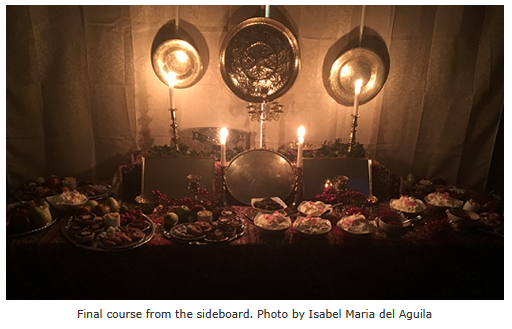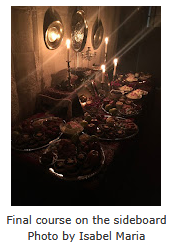 As part of the 2019 Persona Gubbins Challenge, there was a category "Do you think because you are virtuous, that there shall be no more cakes and ale?". Rather than enter an item of persona appropriate food or drink, Meistern Christian entered a whole feast. The challenge entry is shared here, together with some recipe redactions from the feast that were published, by popular request, in the June 2019 issue From The Tower (Southron Gaard's Baronial newsletter).
As part of the 2019 Persona Gubbins Challenge, there was a category "Do you think because you are virtuous, that there shall be no more cakes and ale?". Rather than enter an item of persona appropriate food or drink, Meistern Christian entered a whole feast. The challenge entry is shared here, together with some recipe redactions from the feast that were published, by popular request, in the June 2019 issue From The Tower (Southron Gaard's Baronial newsletter).
In Meistern Christian's words:
Persona Inspiration & Use
"A friend wanted to host a Christmas event with a meal (Southron Gaard, Festa de Natale, December 2018). He wanted a menu suitable for his Lady's persona, i.e. late 1570's Italian noblewoman. I chose to follow Scappi, a chef to various cardinals and pope's, whose Opera dell'arte del cucinare was published in 1570.
I used Scappi's recipes and menus to construct a feasibly accurate light summer celebration meal for Italy in the 1570's.
Design, Materials, and Construction
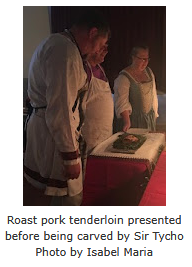 I reviewed all the translated menus from Scappi I could find, and established the appropriate number of courses and dishes for a light feast. I reviewed the dishes on those menus, and arranged them as to the appropriate course in which they should appear (certain dishes appear only in certain courses). From those lists I selected a long list of the dishes I preferred. Christmas in Italy is obviously not in summer, so some flexibility was necessary in selecting recipes from both the summer and December menus.
I reviewed all the translated menus from Scappi I could find, and established the appropriate number of courses and dishes for a light feast. I reviewed the dishes on those menus, and arranged them as to the appropriate course in which they should appear (certain dishes appear only in certain courses). From those lists I selected a long list of the dishes I preferred. Christmas in Italy is obviously not in summer, so some flexibility was necessary in selecting recipes from both the summer and December menus.
I then narrowed down the long list of recipes balancing an authentic light Scappi summer menu with the modern constraints / considerations of the event: a menu of light dishes and salads appropriate for a warm summer evening, a balanced menu (for modern tastes), recipes I liked, available seasonal produce, preparation time and cooking facilities, recipes with a nod to Christmas (period or modern Christmas) and keeping a low ticket price in mind.
Festa de Natale Feast Menu:
Primo Servitio di credenza (First service from the sideboard)
- Uva fresca di piu sorte (Fresh grapes of various sorts) - Formaggio (Cheese) - Olive di piu sorte (Olives of various sorts) - Insalata di citrioli et cipollette (Cucumber and onion salad) - Insalate di cedro tagliate in fettoline, servite con zuccaro, sale & acqua rosa (Orange salad with sugar, salt, and rosewater) - Prosciutto cotto in vino, tagliata, servitto freddo (Ham cooked in red wine, with a dressing of capers, currants, sugar, vinegar) - Amaretti (Almond cookies) - Pane con buttiro (Bread butter)
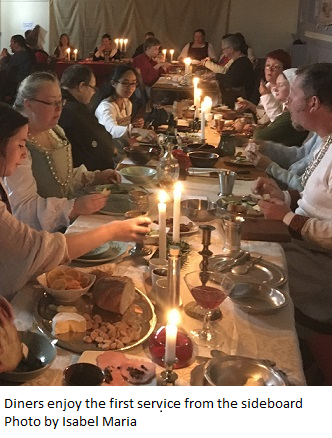
Primo et ultimo servitio di cucina (First and last service from the kitchen)
- Polli arrostite (Roast chicken) - Il lomboletto di porco domstico in piu modi (Roast pork tenderloin) - Mostardo amabile (Sweet mustard) - Sapore vino di melangranate (Pomegranate wine sauce) - Minestra di tagliatelle (A thick soup of Tagliatelle) - Bolognese tourte (for vegetarians) (Cheese and chard tart) - Cuocere Broccoli asciutti et cauli (Broccoli and cauliflower with sour orange juice, oil and garlic) - Insalata di misto (Mixed salad)
Secondo et ultimo servitio di credenza (Second and last service from the sideboard)
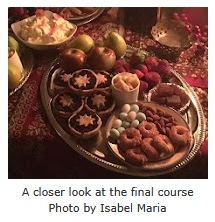 - Mele et pere crudo di piu sorte (Raw pears and apples)
- Formaggio (Cheese)
- Grani di melegranate et Fragole (Pomegranate seeds and strawberries)
- Mandole (Almonds)
- Neve di latte (A dish of Snow)
- Per fare pizza a un'altro modo (A dried fruit tart: pastry)
- Ciambelle (Italian cookies)
- Gelo di cotogne (Quince paste)
- Mele et pere crudo di piu sorte (Raw pears and apples)
- Formaggio (Cheese)
- Grani di melegranate et Fragole (Pomegranate seeds and strawberries)
- Mandole (Almonds)
- Neve di latte (A dish of Snow)
- Per fare pizza a un'altro modo (A dried fruit tart: pastry)
- Ciambelle (Italian cookies)
- Gelo di cotogne (Quince paste)
Selected Recipes:
In perusing Scappi's Opera, I chose the following two sauces to accompany the roast chicken and roast pork on the menu. The sweet mustard seemed an ideal accompaniment for the pork, since it contained both mustard and apples, oft companions to the pig. I'm very, very fond of pomegranates, and managed to acquire a few inexpensively, so that was an easy second choice.
Mostardo Amabile (Sweet Mustard)
Scappi Bk II.276, Bk VI. 199
To prepare sweet mustard Get a pound of grape juice (i.e. must), another pound of quince cooked in sugared wine, four ounces of apples cooked in sugared wine, three ounces of orange peel, two ounces of candied lime peel and half ounce of candied nutmegs; in a mortar grind up all of the confections along with the quince and apples. When that is done, strain it together with the grape juice, adding in three ounces of clean mustard seed, more or less, depending on how strong you want it to be. When it is strained, add in a little salt, finely ground sugar, half an ounce of ground cinnamon, and a quarter-ounce of ground cloves. It is optional just how mild or strong you make it. If you do not want to grind up the confections, beat them small. If you do not have any grape juice, you can do it without, getting more quince and apples cooked as above.
As it was not yet the season for quinces, I used only apples in this recipe. Many modern fruit varieties are generally sweeter than in period, there is probably less sugar used in this recipe than perhaps the original (although I may have made up for that by having a sweet tooth). I did indeed not have grape juice to hand, so substituted more apples as suggested by Scappi. I added a little red wine (from the following recipe) for a little "grape must" flavour. Unable to find candied nutmegs, and not particularly convinced about the merits of candying them at all, I grated some nutmeg instead. I had both orange and lemon peel on hand, but no lime. You might vary the types of mustard you use; in this case I had yellow and black seeds in the pantry.
1 kg apples 1/2 cup sweet white wine 3 T sugar (use 2 T (or to taste) for the apples, reserve the rest for the mustard) 150 g orange and lemon (or lime) candied peel 1/2 t grated nutmeg 2 T red wine 90g yellow mustard seed 2 T black mustard seed 1/2 t salt 1/2 - 1 t ground cinnamon bark 1/4 t cloves
Peel and chop the apples, and cook in the wine (in this case a sweet white dessert wine I had left over), adding a 2 T sugar (or to taste). Cook until soft, but not yet a pulp. Cool a little.
Using a mortar or food processor or similar, grind the apples and peel (reserve any liquid from the cooked apples and add only to loosen the mixture if required). Grind very finely so there are no chunks of peel or fruit (as this can impair the texture).
Grind the mustard seeds. You may (or may not) wish to sift out any seed coats leaving only the mustard "flour". In this case, as I like a whole grain mustard, the seed coats were left in. Add to the apples along with the red wine or must. Grind (if necessary) the salt, 1-3 (depending on taste) teaspoons of sugar, cinnamon and cloves; add these to the mustard, and adjust the seasonings to your taste if required (we preferred to add a little more cinnamon).
The mustard flavour will develop over the next 24 hours or so. We did not find that the mustard became stronger or sharper, although we had been warned that it may. Taste and if required, adjust seasonings before serving.
Sapore vino di melangranate (Pomegranate wine sauce)
Scappi Bk II.264
To prepare a pomegranate sauce Get a pound and a half of clarified pomegranate wine and a pound of sugar and boil the mixture over a low coal fire until it is cooked – which you can tell by a test done with a globule (see recipe 267 blob of syrup does not spread when touched and recipe 270 boiling should reduce this very sweet ‘pomegranate wine sauce’ by two-thirds). Above all make sure the sugar is fine; and boil it slowly. It is then kept in jars of glass or glazed earthenware.
Alas, but I had no pomegranate wine, and doubted I could find any, nor did I have time to ferment wine even if I had been lucky enough to afford enough fruit and cruel enough to crush those ruby red seeds. Recalling that many modern “fruit” wines are indeed grape based, I substituted a concoction of pomegranate molasses and red wine. The molasses being concentrated fruit juice, little sugar was required to sweeten the sauce.
1 250 ml bottle of pomegranate molasses 1 750 ml bottle of red wine (preferably a lighter flavoured wine, I used a nice little drop from just outside Rome) 2 T sugar (or to taste)
Add wine and molasses to a pot and bring to the boil. Lower the heat and simmer until it reaches the globule stage / is reduced by just over half (the molasses is already reduced, so you may not need to reduce it by two- thirds to get the same result). When it is close to being reduced enough, add sugar to taste and ensure this is fully dissolved (beware, the mixture will concentrate and grow sweeter on heating so go cautious with the amount of sugar).
Keeps well in a sealed container in the fridge (for months).
 Recipe translations from:
The Opera of Bartolomeo Scappi (1570): L'arte et prudenza d'un maestro cuocu (The Art and Craft of a Master Cook), Lorenzo Da Ponte Italian Library. Terence Scully. Publ. University of Toronto
Press, 2008.
Recipe translations from:
The Opera of Bartolomeo Scappi (1570): L'arte et prudenza d'un maestro cuocu (The Art and Craft of a Master Cook), Lorenzo Da Ponte Italian Library. Terence Scully. Publ. University of Toronto
Press, 2008.
Bonus Recipes (Not period)
As the pomegranate sauce keeps so well, it can be used in various following ways:
Glaze / dressing: use as you would a balsamic glaze (e.g. drizzled over a roast vegetable, feta, pomegranate seed and green salad; drizzle over kumara or pumpkin before roasting; marinade meat in the sauce before grilling / roasting, etc).
Lime and Pomegranate Margarita: add 1/2-1 t of the sauce to (the ingredients for your favourite recipe for) a lime margarita, shake well and serve.
Pomegranate and bubbly cocktail: add 1/2 - 1 t of the sauce to a champagne glass, top with your favourite wine. Float some pomegranate seeds in the bubbles.
Pomegranate and rose trifle: dilute 2-3 T of the sauce with a little warm water or sweet wine to the consistency of strong espresso. Dip (do not soak) half of one pack of sponge fingers in the sauce, and line the bottom of a trifle dish. Sprinkle over some pomegranate seeds, sliced strawberries, and slightly crushed raspberries. Whip 500 ml cream, flavour with a little honey or icing sugar, and add 1/2 t rose water (or to taste). Fold 2/3 cream into 1 litre of custard. Spread 1/2 of the custard/cream mixture over the fruit and sponge fingers. Repeat a layer of sponge fingers, fruit, and custard cream. Cover and refrigerate for 4-6 hours to allow flavours to mingle. Cover with the remaining cream, and decorate with pomegranate seeds, raspberries and sliced strawberries. Excellent for the Christmas table.
